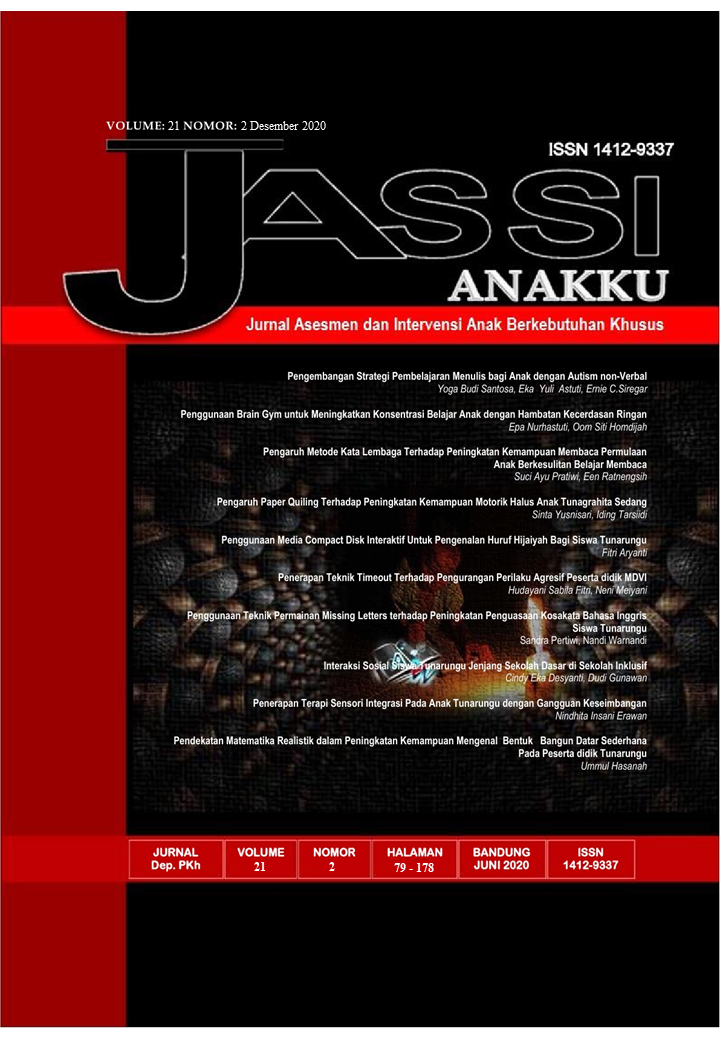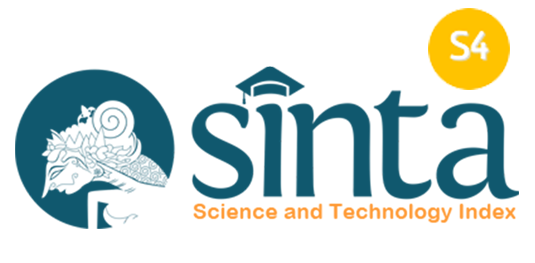Drill Method in Learning to Count for Children with Down syndrome
Abstract
This study aimed to determine the drill method in improving the numeracy skills of children with Down syndrome. The method used is simple quantitative. The subjects of the study were two children with Down syndrome in an elementary school inclusion class. Data were collected through written tests and documentation of the learning process. The results showed a significant increase in basic numeracy skills after the consistent application of the drill method. The implications of this study indicate that the drill method, through repetition and structured practice, can help children with Down syndrome strengthen their basic numeracy skills. This study suggests that teachers use a repetitive practice-based approach more often in teaching basic mathematics.
Keywords
References
Abbasian, G. R., & Ebrahimi, F. (2020). Assessing down syndrome efl learner's language ability: incorporating learners-teachers' perspectives. English Language Teaching, 13(3), 45-67.
Alhusaini, A. A., Al-Walah, M. A., Melam, G. R., & Buragadda, S. (2020). Variables correlated with physical activity and conformance to physical activity guidelines in healthy children and children with down syndrome. Physikalische Medizin, Rehabilitationsmedizin, Kurortmedizin, 30(03), 141-145.
Amila, F., & Ostadmohamadi, J. (2024). Implementation of the islamic religious education learning model for deaf students: empirical study in salatiga state special middle schools. Jurnal Pendidikan Agama Islam Indonesia (JPAII), 5(2), 56-64.
Dewi, N. A. K., Trisnawati, T., & Kristina, M. (2020). The drill method with realistic approach to improve learning outcomes of descriptive statistics in higher education. Jinop (Jurnal Inovasi Pembelajaran), 6(2), 215-226.
Gupta, I., Tran, N., Devegowda, D., Jayaram, V., Rai, C., Sondergeld, C., & Karami, H. (2020). Looking ahead of the bit using surface drilling and petrophysical data: machine-learning-based real-time geosteering in volve field. SPE Journal, 25(02), 990-1006.
Hazbeh, O., Aghdam, S. K. Y., Ghorbani, H., Mohamadian, N., Alvar, M. A., & Moghadasi, J. (2021). Comparison of accuracy and computational performance between the machine learning algorithms for rate of penetration in directional drilling well. Petroleum Research, 6(3), 271-282.
Maryanti, R.; Hufad, A.; Nandiyanto, A. B. D.; And Tukimin, S. (2021). Teaching the corrosion of iron particles in saline water to students with special needs. Journal Of Engineering Science And Technology, 16(1), 601-611.
Maryanti, R.; Hufad, A.; Nandiyanto, A. B. D.; And Tukimin, S. (2021). Teaching heat transfer on solid-to-liquid phase transition phenomena to students with intellectual disabilities. Journal Of Engineering Science And Technology, 16(3), 2245-2259.
Maryanti, R.; Hufad, A.; Sunardi, S.; And Nandiyanto, A. B. D. (2022). Teaching high school students with/without special needs and their misconception on corrosion. Journal Of Engineering Science And Technology, 17(1), 0225-0238.
Maryanti, R.; Hufad, A.; Sunardi, S.; And Nandiyanto, A. B. D. (2021). Analysis of curriculum for science education for students with special needs in vocational high schools. Journal Of Technical Education And Training, 13(3), 54-66.
Maryanti, R.; Hufad, A.; Tukimin, S.; Nandiyanto, A. B. D.; And Manullang, T. I. B.; (2020). The importance of teaching viscosity using experimental demonstration from daily products on learning process especially for students with special needs. Journal Of Engineering Science And Technology, 15(Special Issue), 19-29.
Maryanti, R.; Nandiyanto, A. B. D.; Manullang, T. I. B.; Hufad, A.; And Sunardi, S. (2020). Adsorption of dye on carbon microparticles: physicochemical properties during adsorption, adsorption isotherm and education for students with special needs. Sains Malaysiana, 49(12), 2949-2960.
Primawati, R. S., Susilawati, S., & Sukandar, H. (2019). Music, dance and song about tooth brushing in the improvement of knowledge, teaching practices and dental cleaning status mouth in children down syndrom in SLB Kota Tasikmalaya. Jurnal Kesehatan Gigi, 6(2), 157-162.
Rusyani, E., Ratnengsih, E., Putra, A. S., Maryanti, R., Al Husaeni, D. F., & Ragadhita, R. (2022). The drilling method application using abacus to arithmetic operations skills in student with hearing impairment at special school. Indonesian Journal Of Community And Special Needs Education, 2(1), 1-10.
Wang, Q., Gao, H., Yu, H., Jiang, B., & Liu, B. (2019). Method for measuring rock mass characteristics and evaluating the grouting-reinforced effect based on digital drilling. Rock Mechanics And Rock Engineering, 52, 841-851.
Wood, R., Feng, J. H., & Lazar, J. (2024). Health data visualization literacy skills of young adults with down syndrome and the barriers to inference-making. ACM Transactions On Accessible Computing, 17(1), 1-1.
Zhong, R., Johnson Jr, R. L., & Chen, Z. (2020). Using machine learning methods to identify coal pay zones from drilling and logging-while-drilling (lwd) data. Spe Journal, 25(03), 1241-1258.
DOI: https://doi.org/10.17509/jassi.v24i2.83267
Refbacks
- There are currently no refbacks.
Copyright (c) 2025 Universitas Pendidikan Indonesia

This work is licensed under a Creative Commons Attribution-ShareAlike 4.0 International License.




